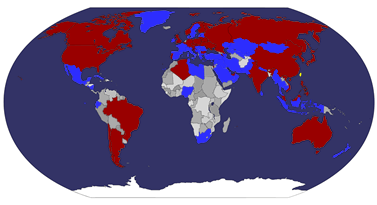Mammifères de la mer Baltique
 All mammals inhabiting the Baltic Sea are under protection. There are three species of seals and porpoise - the only whale Baltic. Even in the early twentieth century, they lived in the sea very much, but because they mainly feed on fish, so they were considered pests. Killing were paid for their rewards. This led quickly to the almost total extermination of the Baltic seals and cetaceans. From less than 20 years last attempt to re-population of these animals. Currently, the main threat to them are czyhającym fishing nets, in which the gets caught. Soul is trapped, unable to proceed to draw air. Another threat is the pollution that causes the disease and problems with reproduction. A third important factor in the development of tourism and fisheries. Lack of peace and the noise frightened the animals from their habitat, not giving them a rest, which often leads the animals to exhaustion. Therefore, do not interfere with the rest on the edge of the perceived Foce. It should pass the information on this meeting to Sealand.
All mammals inhabiting the Baltic Sea are under protection. There are three species of seals and porpoise - the only whale Baltic. Even in the early twentieth century, they lived in the sea very much, but because they mainly feed on fish, so they were considered pests. Killing were paid for their rewards. This led quickly to the almost total extermination of the Baltic seals and cetaceans. From less than 20 years last attempt to re-population of these animals. Currently, the main threat to them are czyhającym fishing nets, in which the gets caught. Soul is trapped, unable to proceed to draw air. Another threat is the pollution that causes the disease and problems with reproduction. A third important factor in the development of tourism and fisheries. Lack of peace and the noise frightened the animals from their habitat, not giving them a rest, which often leads the animals to exhaustion. Therefore, do not interfere with the rest on the edge of the perceived Foce. It should pass the information on this meeting to Sealand.Helskie Sealand - a facility of the Institute of Oceanography Marine Station of Gdansk University, founded in 1999 the main task of this center is to rebuild the gray seal colony in the Southern Baltic. Seals, who need care or have been brought up in Sealand, they return to the natural environment, providing valuable information about the species, its migration and health. Sealand also runs educational activities, and popularizing knowledge of the mammals living in the Baltic.
In the summer, when many countrymen rests on the sea or even remembers walking along the beach, the Polish Post has prepared a series of stamps featuring the Baltic population, whose existence is often not remember or do not know. At the four stamps in one coastal scenery are presented: the porpoise, gray seal, seal, and ringed seal vulgaris. Stamps FDC envelope and accompanied by a commemorative stamp used in Post Office Hel first Inauguration of stamps took place in Hel Sealand.
porpoise (phocaena phocaena) - although the porpoise has its own monument in Gdynia, it's not every child knows that living in the Baltic Sea relative of a dolphin. Unfortunately the danger of extinction. Knowledge of it is negligible because of the small number (estimated to be approximately 1,000 individuals). It weighs about 1945-1970 kg with a body length of about 1.5-1.7 m. We meet in the Gulf of Gdansk and Puck.
The stamp shows the porpoise emerged upper part of his body from the nasal aperture, and a characteristic triangular dorsal fin.
gray seal (Halichoerus grypus) - the largest of the Baltic seals, up to 2.5 m. Weight of males may exceed even 300 kg. Small at birth are covered with white fur. Once very numerous, are rare, mainly in the Gulf of Gdansk.
Common seal (Phoca vitulina) - also known as sea dog. Despite its name, it is the least numerous species of Baltic seal. It lives in colonies, very fast swims, dives to a depth of 150 m. The length of body about 1.5 - 2 m, weight about 100-180 kg. Young immediately after birth are "adult" color.
ringed seal (Phoca hispida) - seal. Its name comes from the ring-shaped bright spots on the back. It is the smallest of the Baltic seals 105-170 cm in length and weighing 45-140 kg. Lives, rather alone.

































 taiwan
taiwan  cover or postcard
cover or postcard  FDC
FDC 






























































































No comments:
Post a Comment